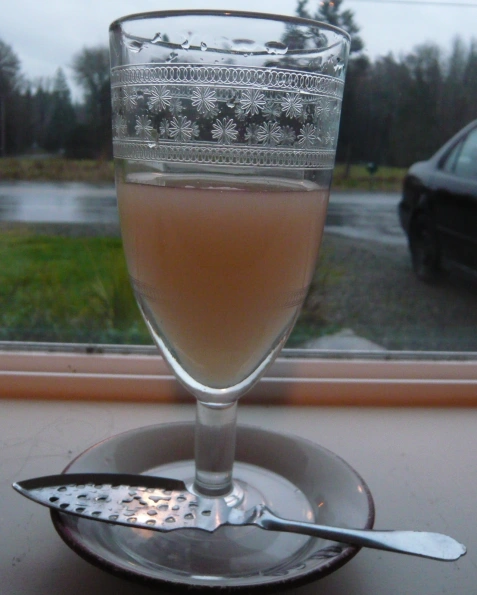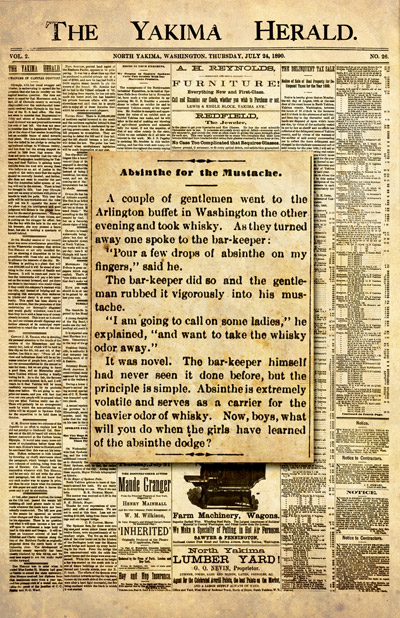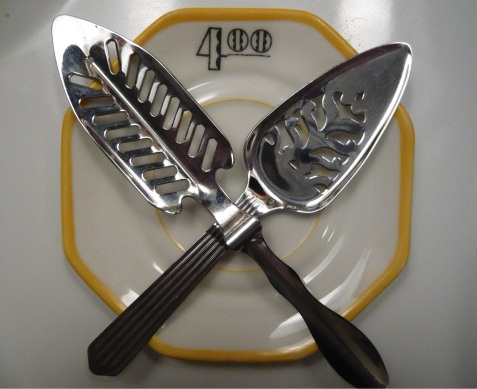Of all the various accessories associated with liquor and cocktails, arguably none of them are as unique and specific in use as the absinthe spoon. These little trowels of tastiness are essentially spoons with holes poked in them, and the apparent perversion of such an austerely utilitarian tool as the common spoon was undoubtedly pointed out by more than one of absinthe’s detractors before the Great War as the sign of a damnable and devilish product. ‘Babylon has fallen!’ proclaims the sweaty revivalist/prohibitionist, dramatically attempting to quench his thirst with water from a nearby well, yet painfully unable to do so because the water falls through the holes before he’s even able to bring the spoon to his lips. One can almost hear the weeping and the gnashing of teeth.
Or perhaps it never came to that. Based on noted historian Benoît Noël’s research of hundreds of documents of the period (which hey, I would have been happy to do myself, except that I don’t speak French), it seems that the iconic absinthe spoon did not make it’s debut until approximately 1889, nearly 100 years after distilled absinthe as a beverage made it’s debut (and at least 20 years after the anti-absinthe contingent mobilized). Prior to that, absinthe seems to have been served most often without sugar, a concept which makes sense given that almost no other liquor has sugar added to it. Presumably, the idea of adding sugar came into play as a method of minimizing the bitter wormwood taste and making the drink more palatable to those used to Swiss blanches (which are naturally sweeter), as well as to women, who were increasingly becoming more independent and empowered during the latter half of the 19th century.
The Swiss seem themselves to have introduced the absinthe grille a few years before the absinthe spoon, and an absinthe grille functions in much the same way: it is placed over a glass containing a dose of absinthe, and sugar cubes are rested on its perforated surface, ultimately to be dissolved into the drink by dripping water onto them from a carafe or fountain. However, grilles do not have a handle, and they are also too wide to fit inside of most glasses, so a standard spoon had to be used to mix the sugar granules into the finished drink. At some point, it would seem that some anonymous soul had the brilliant idea of combining the two implements into one magnificently elegant tool; and yet, as loathe as I am to admit it, it may be that we owe the invention (or at least the popularization) of the absinthe spoon to marketing.
The year 1889 isn’t an arbitrary one to use as the date of the earliest known absinthe spoon (as well as the earliest-known illustration featuring an absinthe spoon – see below for that). As much of an icon as the absinthe spoon became, the most iconic piece of metal associated with France is unquestionably the Eiffel Tower. This architectural masterpiece was completed in 1889 as the entrance to the 1889 World’s Fair, and as impressive as it is today, it must have been a jaw-droppingly marvel to the average fair-goer in the late 19th century. A plethora of memorabilia associated with the Eiffel Tower was soon to follow, and one of the first was a commemorative absinthe spoon. This detailed and somewhat baroque spoon has since become one of the most highly sought-after collectibles in the absinthe world.
After the idea of sugaring absinthe via a perforated spoon came into fashion, a wide variety of spoons entered the marketplace, although most of the types typically used in cafes and bistros throughout France tended to be fairly simple. That being said, in the satirical illustration of General Boulanger done by Sem (Georges Goursat) below, you can just barely make out a long, curved tip on the spoon, a feature found on a type of absinthe spoon called “Losange étirée,” or “elongated Diamonds”). This elongated type of spoon is quite a bit rarer than those without the curved tip, and appears to have been intended as a way to rest the tip of the spoon on the edge of a bistro saucer so that the spoon did not come into contact with the table and remained sanitary (or at least, that’s the conclusion S—- and I came to after examining one — I haven’t yet been able to confirm that through any historical reference).
I’ll go into much greater detail about absinthe spoons at a later time. In the meantime, enjoy the comical art and feel free to come up with your own slant on what it means. To date, there hasn’t been any definitive interpretation of the humor here. General Boulanger did have a large base of support around 1889 and had a window of opportunity to gain great power in France, then inexplicably fled to England, after which his backers turned away in disappointment, he was pronounced a traitor by the French Senate, and a couple of years later he came back across the English channel to Belgium, where he killed himself at the graveside of his mistress who had died the year before. Ironically, while he seems to have been a user of opiates, General Boulanger does not seem to have been much of an absinthe drinker at all, and so the absinthe glass and spoon are likely symbolic of French decadence, excess, or something else entirely. If you think you might know, by all means, please comment!









